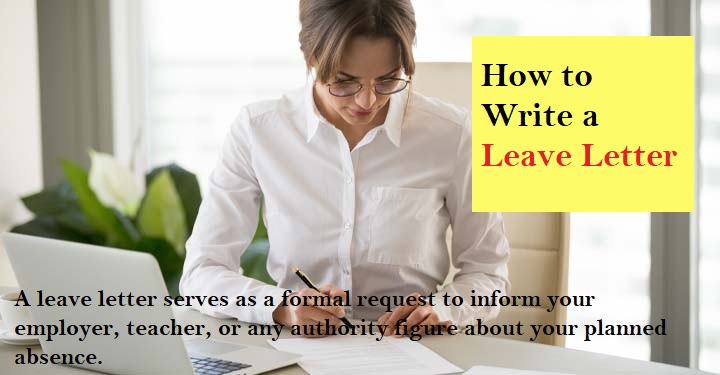Leave letters are a crucial form of communication in professional and academic settings. Knowing how to write a well-structured leave letter can ensure that the concerned authority understands and approves your absence. This complete guide (How to Write a Leave Letter) will walk you through the steps to craft an effective leave letter, with examples and tips to make the process easier.
Why is Writing a Leave Letter Important?
A leave letter formally requests to inform your employer, teacher, or any authority figure about your planned absence. It helps maintain transparency and ensures proper record-keeping.
Key Benefits of a Leave Letter:
- Maintains professionalism and respect for the authority.
- Provides clarity about your absence.
- Helps the authority plan adjustments during your absence.
Components of a Leave Letter
1. Subject Line
Always start with a clear and concise subject line to indicate the letter’s purpose.
Example: “Request for Leave from [Start Date] to [End Date]”
2. Salutation
Use a polite and professional greeting, such as:
- For formal letters: “Dear [Recipient’s Name/Title]”
- For informal letters: “Hi [Name]”
3. Body of the Letter
- Opening Paragraph: Clearly state the purpose of the letter.
- Details of Leave: Mention the dates and reason for your leave.
- Assurance: Offer to complete pending tasks or delegate responsibilities.
- Closing Paragraph: Thank the recipient for their understanding.
4. Sign-Off
Use a courteous closing, such as “Sincerely” or “Best Regards,” followed by your name and designation.
Format How to Write a Leave Letter
Follow this structured format for your leave letter:
| Section | Details |
|---|---|
| Header | Include your name, address, and date at the top left of the letter. |
| Recipient Details | Mention the recipient’s name, designation, and address below your header. |
| Subject Line | Clearly state the purpose of your letter. |
| Salutation | Greet the recipient respectfully. |
| Body | Explain the reason, duration, and details of your leave. |
| Closure | Offer gratitude and assurance of task management. |
| Signature | End with your name and signature. |
Sample Leave Letter Templates
1. Formal Leave Letter for Work
Subject: Request for Leave from [Start Date] to [End Date]
Dear [Manager’s Name],
I am writing to formally request leave from work for the period of [Start Date] to [End Date]. The reason for my leave is [brief reason, e.g., personal matters, medical reasons, etc.].
I have ensured that all my pending tasks are completed, and I have delegated responsibilities to [Colleague’s Name] during my absence. Please let me know if you require any additional information.
Thank you for your understanding and support. I look forward to your approval.
Sincerely,
[Your Name]
[Your Job Title]
2. Leave Letter for School
Subject: Leave Request for [Your Child’s Name]
Dear [Teacher’s Name],
I am writing to request leave for my child, [Child’s Name], a student in [Class/Grade], from [Start Date] to [End Date]. The reason for this leave is [reason, e.g., family commitment, illness, etc.].
We will ensure that [Child’s Name] catches up on all missed assignments and lessons. Please let me know if any additional documentation is required.
Thank you for your understanding.
Sincerely,
[Your Name]
[Relationship to the Student]
3. Emergency Leave Letter
Subject: Urgent Leave Request
Dear [Recipient’s Name],
I regret to inform you that I need to take leave from [Start Date] due to unforeseen circumstances. I will keep you updated about my availability and ensure a smooth handover of responsibilities.
Thank you for your understanding during this difficult time.
Best Regards,
[Your Name]
Tips for Writing an Effective Leave Letter
- Be concise and specific: Avoid unnecessary details and keep the letter focused.
- Maintain a polite tone: Show gratitude and professionalism throughout the letter.
- Provide contact information: Ensure you can be reached during your absence.
- Proofread: Double-check for grammar and spelling errors.
Common Mistakes to Avoid
- Vague Reasons: Be clear about why you need the leave.
- Last-Minute Requests: Submit the letter well in advance, if possible.
- Overlooking Responsibilities: Address how your tasks will be managed in your absence.
- Casual Language: Maintain a professional tone at all times.
When to Use Email vs. Printed Letters
| Scenario | Preferred Method |
| Formal office setting | Printed Letter |
| Informal or quick communication | |
| Emergency or last-minute requests |
Disclaimer: This article provides general guidelines on writing leave letters and is meant for informational purposes only. The format, tone, and content of your letter should be adapted to the specific requirements of your institution or organization. Always review and adhere to your company’s leave policies before submitting a request.

